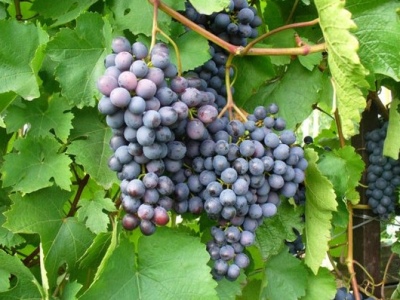
- Authors: A.I. Potapenko
- Appointment: technical
- Berry color: purple
- Taste: simple
- Frost resistance, ° C: -35
- Bunch weight, g: 250-300
- Yield: 20-50 kg per bush
- Flower type: bisexual
- Damage by wasps: not affected
- Density of the bunch: medium density
Technical grapes are as popular as table grapes. The Amethyst grape belongs to the technical grade. In this article, we will consider the history of breeding, characteristics of the variety, yield, taste, agrotechnical work, frost resistance and shelf life.
Breeding history
The Amethystovy grape was obtained by crossing the parental pair of varieties Tsimlyanskiy black and Amurskiy. The author of this hybrid is an amateur breeder Potapenko A.I.This variety is also called the Amur Novocherkassky grape. This is necessary so that there are two more grape varieties with the same name - Samara Amethyst and Super-early Amethyst. They all used different parental pairs and had different breeders. This means that the characteristics of all three species are different. This must be remembered in order to purchase exactly that variety. The article discusses the Novocherkassky Amethystovy variety.
Description
Bushes are medium-sized, small. The vines ripen well, but they are not as thick in diameter. The branches spread and bent to the ground, so it is necessary to make a system of trellises. Leaves are green, without characteristic lobes, wedge-shaped. They are small, dull, with a slight roughness.
There are several factors on the positive side:
high productivity;
frost resistance;
taste qualities;
transportability.
Ripening period
The variety is early maturing, so you can harvest in August. The ripening period for fruits takes up to 90 days.
Bunches
The bunches are not very dense, cylindrical in shape. There is no looseness. By weight, one brush pulls from 250 to 300 g, there are also more weighty clusters weighing up to 0.7 kg.
Berries
Berries are medium-small, diameter is from 9 to 13 mm, weight is 3-4 g. Rounded in shape. The color of the berries ranges from purple to black. The skin is dense, glossy, there is a waxy coating. The pulp is juicy, fleshy, the pulp can be colored from the peel.
Taste
The taste is pleasant, harmonious, there are subtle notes of nutmeg. The sugar content is 20-25%, and the acidity is 7 g / dm3. This suggests that the berries are quite sweet.
Yield
The yield of grapes Amethyst at a height, from one bush, if 3-4 clusters are placed on the vine, 40 to 50 kg can be removed. If the bushes are smaller, then the yield will be 20-30 kg.


Growing features
Planting grapes Amethyst is best done in the spring. May is ideal for this. Disembarkation takes place in early or late May, depending on the region. It is necessary that the air temperature warms up to +15 degrees.
It is best to plant seedlings from other crops at a distance of 2-3 m so that they do not block the flow of light.
The soil should be slightly acidic, loamy and loose. Before planting, the site should be dug up with fertilizers. Spill the selected area liberally. This is best done when the snow melts and the ground thaws.
The grapes do not like too wet soil, so it is necessary to draw up a watering schedule. If a large amount of precipitation falls during the season, then the culture does not need additional watering.
Landing
Planting of seedlings takes place in the prepared soil. The holes are dug with a diameter of 0.5 m, a depth of 0.8 m. Broken brick or pebbles are poured at the bottom of the hole, this will act as drainage. Then the drainage is covered with a fertile layer of earth with a small hill. The seedling is carefully lowered into the hole and covered with earth. The bushes are spilled abundantly with water and, if necessary, are immediately tied to trellises.

Pollination
The flowers of the hybrid are small, yellow. Peduncles are found both of both sexes and unisexual. Therefore, before buying, it is necessary to clarify what type the flower stalks of the seedling belong to.
Pruning
Pruning for this grape is no different from other crops. In the fall, the vines are shortened by 4-6 eyes. Lateral shoots are cut by 5 cm if their length is more than 20 cm. In the spring, all frozen branches are cut, and those that have broken.
In the summer, excess foliage and shoots are removed, which began to grow in the wrong direction.



Frost resistance and the need for shelter
The technical grade Amethystovy has good frost resistance, it can withstand up to -35 degrees. Adult vines do not need additional shelter if they are gradually accustomed to the cold.
Young shoots take refuge, which are only 2-3 years old. Frostbite of the vine most often occurs in them, since the root system is not yet fully ripe. It is worth covering with agrofibre no later than the last week of September.
You can stop covering the vines in the fourth year after planting the seedling in the ground.

Diseases and pests
Although the manufacturer claims that the grapes have good immunity, this is not at all the case. If you do not carry out timely spraying against fungal diseases, then the following diseases can develop:
gray rot;
mildew.

If a grape is exposed to any disease or insect, this always affects its appearance.
Storage
The grapes have high transportability and shelf life up to 1 month. It is not worth storing grapes for too long; it must be processed or eaten immediately.











































































